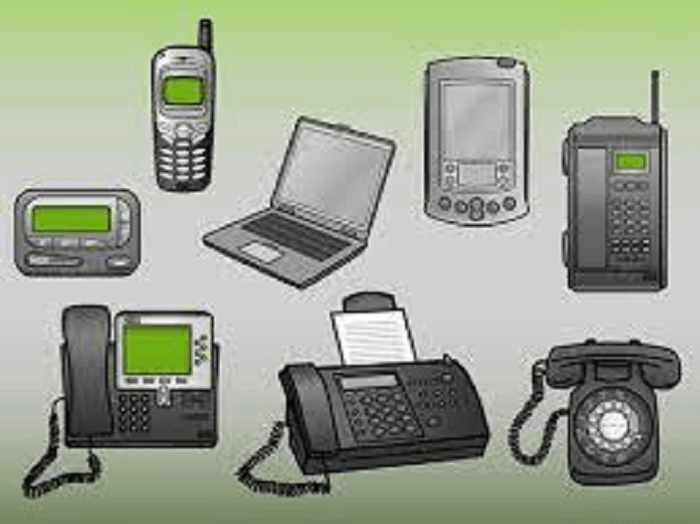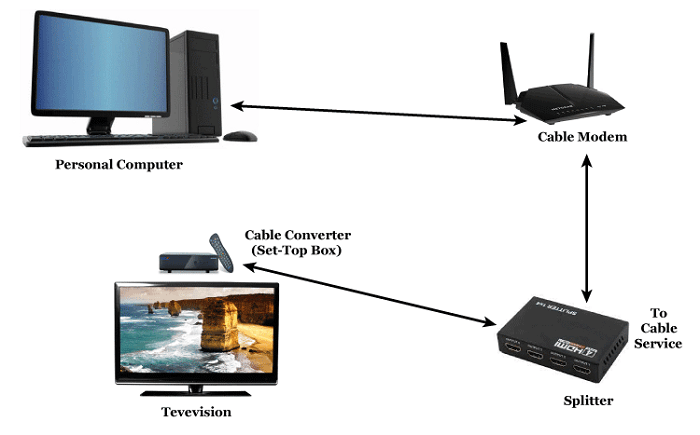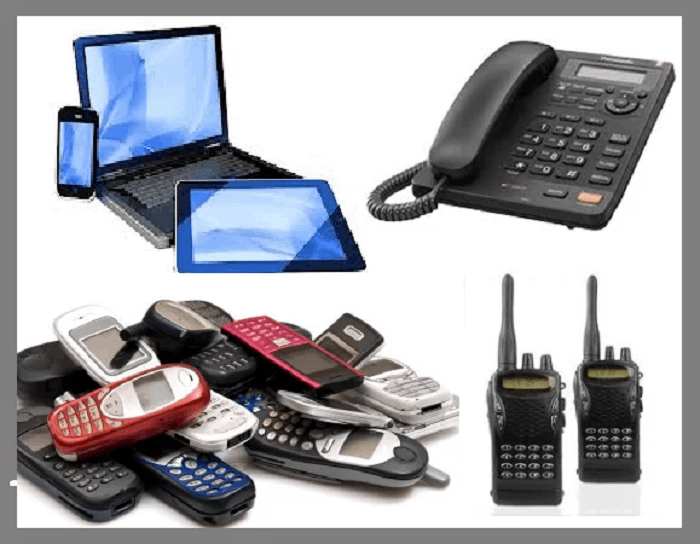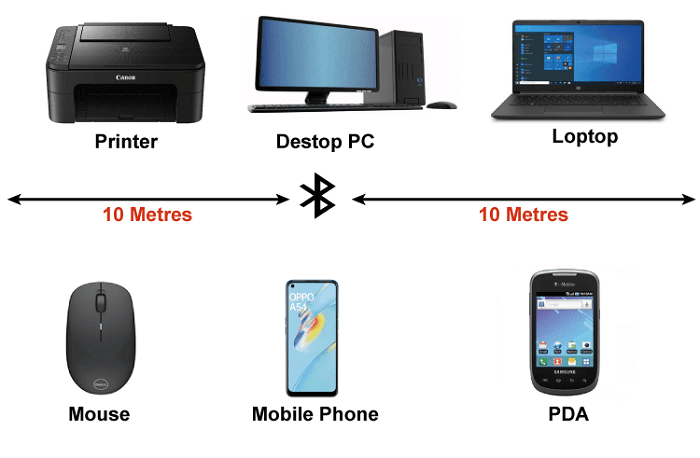What are Communication Devices?
Communication devices transmit data, instructions and information between sender and receiver devices. Communication devices are used to send information from one place to another. Examples include telephones, radios, televisions, computers, and smartphones. These devices allow individuals to communicate with others, whether it be through voice, text, or video. They have greatly impacted society by making communication faster, more convenient, and more accessible these devices have greatly improved and expanded how people can communicate, both locally and globally.

Types of Communication devices:
Types of communication devices are given below:
1) Dial-up Modem: A dial-up modem is a type of modem that uses a telephone line to connect a computer to the internet. It modulates and demodulates analogue signals, allowing digital data to be transmitted over a telephone line. Dial-up modems were widely used in the 1990s and early 2000s before the widespread adoption of broadband internet connections.
They typically had a maximum data transfer rate of 56 kbps (kilobits per second). Dial-up modems are now mostly obsolete, as they are slower and less reliable than other forms of internet connectivity such as DSL, cable and fibre optic. Those alternatives and the advent of the wireless internet have largely replaced them.
2) ISDN and DSL Modems: ISDN (Integrated Services Digital Network) and DSL (Digital Subscriber Line) are digital communication technologies used to connect to the internet. ISDN is a technology that allows for the continuous transmission of voice, video, and data over a single telephone line. It uses digital signalling to transmit data faster than traditional analogue modems and typically offers 128 kbps or higher rates. It is typically faster than a dial-up modem and can be used for applications such as video conferencing and online gaming.
On the other hand, DSL is a high-speed internet type that uses existing copper telephone lines to transmit data. It is considered faster than ISDN and dial-up modems, with typical speeds ranging from 256 kbps to 1 Mbps. DSL modems typically use Asymmetric DSL (ADSL), allowing more immediate download than upload speeds. It's available in different types, such as ADSL, SDSL, IDSL, and VDSL. DSL is more common than ISDN and considered more reliable; DSL technology is still in use today. While ISDN is not widely used and is mostly phased out.
3) Cable Modems: A cable modem is a type of modem that uses a cable television (CATV) network to connect to the internet. Cable modems use the same coaxial cable that delivers cable television programming to homes and provides high-speed internet access. The cable modem converts the digital signal from the cable network into a form that a computer can understand and use to connect to the internet.
Cable modems are generally faster than DSL and dial-up modems and are often the quickest internet connection available in certain areas. They are also capable of providing internet access to multiple devices in a household at the same time. A cable modem typically uses the DOCSIS (Data Over Cable Service Interface Specification) protocol to communicate with the cable service provider's network. The latest version of DOCSIS, DOCSIS 3.1, can provide internet speeds of up to 10 Gbps downstream and 1 Gbps upstream.

4) Wireless Modems: A wireless modem is a type of modem that allows for wireless connectivity to the Internet. It allows multiple devices, such as computers, smartphones, tablets, and other smart devices, to connect to the internet without needing a physical cable connection.
There are several types of wireless modems, including:
- Wi-Fi modem: A Wi-Fi modem, also known as a wireless router, creates a local area network (LAN) that allows multiple devices to connect to the internet wirelessly within a certain range. It uses the Wi-Fi standard to communicate with devices.
- Cellular modem: A cellular modem, also known as a mobile broadband modem, uses a cellular network to connect to the internet. It can connect to the internet on the go, typically with a cellular data plan.
- Satellite modem: A satellite modem uses a satellite in the earth's orbit to connect to the internet; it is mostly used in remote locations where other internet connection forms are unavailable.
- Mesh network: A mesh network is a type of wireless network where each device acts as a repeater, forwarding data from other devices in the network. It allows for a more stable and wider coverage.
- Wireless modems have become increasingly popular as they offer more flexibility and convenience in connecting to the internet. They allow internet access where wired connections are not practical and enable multiple devices to share the same link.
5) Network Cards: The network card is installed inside the computer and typically connects to the motherboard via a PCI or PCI-E slot. It also has a port to connect to the network cable. The network card has a unique Media Access Control (MAC) address that is used to identify the device on the network. It also has a jack or port where a cable can connect to the network. There are two main types of network cards: wired and wireless. Wired network cards use a physical cable, such as Ethernet, to connect to the network.
They are typically faster and more reliable than wireless network cards. On the other hand, wireless network cards use radio frequency (RF) technology to connect to the network wirelessly. They use standards like Wi-Fi or Bluetooth to connect to the network. Network cards are an essential component of any computer that needs to connect to a network, whether a local area network (LAN) or a wide area network (WAN) such as the internet. They play an important role in communication and data transfer between devices on the web.
6) Wireless Access Points: A wireless access point (WAP) is a device that helps to connect wireless devices to a wired network using Wi-Fi or other wireless technologies. It bridges wireless devices and a wired network, such as a router or switch. A WAP typically has one or more antennas that emit radio signals to create a wireless coverage area, also known as a basic service set (BSS), which allows wireless devices to connect to the network. The WAP can be connected to a wired network using an Ethernet cable and assigns IP addresses to connected devices using DHCP. Some of the features that a wireless access point may have include:
- Multiple SSID support, allowing for different networks to be created with varying settings of security
- Support for different wireless standards such as 802.11a/b/g/n/ac
- Quality of Service (QoS) to prioritize certain types of traffic
- VLAN support for separating traffic on various networks
- Captive portal for guest access
Wireless access points can be used to expand the coverage of a wireless network, providing more flexibility and mobility for wireless devices. They can also increase the number of devices connected to a wireless network, creating a wireless distribution system (WDS). The wireless access point can be used in various environments like homes, offices, and public places.
7. Routers: A router is a networking device that forwards data packets between computer networks. It connects multiple networks and directs traffic between them, allowing devices on one network to communicate with devices on another. A router is typically the centrepiece of a home or small office network and is often integrated with other functionality such as a wireless access point, switch, and firewall. Routers use routing tables and protocols to determine the best way for data packets to travel from their source to their destination. They use IP addresses to identify networks and devices and make routing decisions.
Additionally, they also use Network Address Translation (NAT) to allow multiple devices on a private network to share a single public IP address. A router typically has several ports, including at least one WAN (Wide Area Network) port for connecting to an internet service provider (ISP) and several LAN (Local Area Network) ports for connecting to devices on the local scale.

Features of Communication devices
- Sending and receiving text messages
- Making and receiving phone calls
- Connecting to the internet
- Email functionality
- Social media integration
- Camera and video recording capabilities
- GPS navigation
- Voice recognition and dictation
- Music and media playback
- Wireless connectivity (Bluetooth, Wi-Fi)
- Mobile hotspot functionality
- Touchscreen or physical keyboard
- Extended battery life
- Water and dust resistance
- biometric security (fingerprint scanner, facial recognition)
- Mobile payment integration
- Virtual Assistant
- 5G connectivity
- Augmented Reality
- Gaming
- Remote control of other devices
- Multi-language support

Advantages of Communication devices
Communication devices, such as smartphones and computers, offer a variety of advantages, including:
Convenience: They allow individuals to communicate with others quickly and easily, regardless of location. Video conferencing for remote work, meetings and classes.
Connectivity: They provide access to the internet, enabling users to stay connected with friends, family, and colleagues via social media, email, and instant messaging. Accessing the internet to connect with people and resources globally
Productivity: They can help increase productivity by allowing individuals to work remotely, access important information, and complete tasks on the go.
Entertainment: They offer various entertainment options, including music, movies, and games.
Access to information: They provide vast information, allowing users to learn, research and stay informed about current events. Social media integration to connect with people and stay up-to-date on news and events
Cost-effective: They are cost-effective for remote communication and collaboration.
Smart features: They come with smart features like GPS, camera, and sensors which can be used for various purposes.
Errors in Communication device
Communication devices, like all technology, can sometimes experience errors or malfunctions. Some common mistakes that can occur with communication devices include:
- Connection errors: Difficulty connecting to a network or other devices, such as a Bluetooth connection issue or Wi-Fi connectivity problem.
- Battery problems: Difficulty charging the device or unexpected battery drain.
- Software errors: Issues with the device's operating system, such as frozen screens, crashes, or apps not working correctly.
- Hardware issues: Physical damage to the device, such as a cracked screen, broken buttons, or malfunctioning microphone or speaker.
- Signal problems: Difficulty receiving or making calls or texts or poor internet connectivity.
- Security issues: Difficulty with unlocking the device or with biometric security such as fingerprint scanner or facial recognition.
- Sync errors: Difficulty syncing contacts, calendars, or other data between the device and other devices or services.
- Malware or virus: The device may be infected with malware, virus or spyware, and this may cause different errors
Some of these errors can be resolved by troubleshooting or updating the device's software, while others may require professional repair or replacement.
Why do Computers require communication devices?
Computers require communication devices to communicate and exchange data with other devices and networks. Some specific reasons include the following:
Connecting to the internet: Communication devices such as modems and routers allow computers to connect to the internet and access online resources and services.
Sharing files and resources: Communication devices such as network interface cards and wireless adapters allow computers to connect to local area networks, share files, and help with other computers and gadgets.
Remote access and collaboration: Communication devices such as Remote Desktops and VPNs enable users to connect to their computers remotely, work on files, and access resources as if they were physically at the computer.
Printing and peripherals: Communication devices such as USB, Bluetooth or Wi-Fi enable computers to connect to peripherals such as printers, scanners, and cameras, allowing users to print documents, scan images, and transfer files.
Communication and messaging: Communication devices such as email clients and instant messaging apps allow computers to send and receive messages and communicate with other users.
Mobile computing: Communication devices such as smartphones and tablets allow computers to access and process data.
Internet of Things (IoT): Communication devices such as Zigbee, Z-wave, Bluetooth Low Energy (BLE), and Wi-Fi are used to connect IoT devices and allow computers to communicate and control them.
Communication devices are essential for computers to access and exchange information with other devices and networks and to perform various tasks such as communication, collaboration, data transfer, and remote access. This allows for greater productivity, collaboration, and connectivity in personal and professional settings.
Examples of Communication devices
There are several examples of Communication devices:
- Bluetooth device: A Bluetooth device is a type of wireless technology that allows devices to communicate with each other over short distances using radio waves. It is commonly used in many devices, including smartphones, computers, speakers, headphones, etc. Bluetooth devices connect using a process called "pairing," which typically involves entering a code or confirming a prompt on both devices. Once paired, the devices can share data and interact with each other without the need for physical cables or wires.

- Infrared device: An infrared (IR) device is a type of wireless technology that uses infrared radiation to transmit data. This is typically done by emitting infrared light through an LED or similar component and receiving it with a sensor on the receiving device. IR devices are used in many applications, including remote controls for televisions and other electronic devices, wireless headphones, and short-range communications between machines. Unlike Bluetooth, IR devices typically require a direct line of sight between the transmitting and receiving apparatus, as infrared light cannot penetrate solid objects.
- Smartphone: A Smartphone is a mobile device that provides advanced features and capabilities beyond a traditional mobile phone. These features typically include a camera, internet connectivity, and a wide range of apps and other software that can be downloaded and run on the device. Smartphones also usually have a touch screen for interacting with the device, as well as a variety of sensors such as GPS, accelerometer, and compass. Other features like Wi-Fi, Bluetooth and cellular network capabilities are also included. They are often considered mini-computer in the pocket. Popular smartphone operating systems include Android and iOS.
- Wi-Fi device: A Wi-Fi device is a type of wireless device that uses the 802.11 standards to connect to a wireless network and access the internet. Wi-Fi devices include a wide range of devices such as laptops, smartphones, tablets, and desktop computers, as well as specialized machines such as Wi-Fi routers, range extenders, and access points.
These devices connect to a wireless network by communicating with a Wi-Fi router, which acts as a hub for the web and manages the flow of data between the connected devices and the internet. Some devices can also create a Wi-Fi hotspot, allowing other devices to connect and access the internet. Wi-Fi networks use radio waves to transmit and receive data, and the range and speed of the network depend on the specific technology used and the surrounding environment.
- Network and interface card: A network is a group of two or more connected devices, such as computers, servers, printers, and routers, that can communicate with each other and share resources. There are various types of networks, such as (LANs)local area networks, wide area networks (WANs), and wireless networks. An interface card (NIC) or Network Interface Controller (NIC) is a hardware component that connects a computer or device to the web. It is also known as a network adapter or LAN adapter.
The NIC typically includes an Ethernet port and a chip that manages the communication between the device and the network. NICs can be integrated into a computer's motherboard or come as a separate card installed in a slot. They can also come in the form of a USB dongle. NICs have a unique media access control (MAC) address assigned to them by the manufacturer, which is used to identify the device on the network. NICs use protocols such as Ethernet, TCP/IP, and Wi-Fi to communicate with the network.
Complications with Communication devices
- Interference: Devices that use radio frequencies, such as cell phones and Wi-Fi routers, can experience interference from other electronic devices and appliances, resulting in poor signal quality and dropped connections.
- Security: Communication devices can be vulnerable to hacking and other cyberattacks. This can result in compromised sensitive information or unauthorized access to a device or network.
- Dependence: People have become increasingly dependent on communication devices, which can lead to a sense of disconnection from the world around them. People can also experience "phantom vibrations", the feeling of receiving a message when the device is not vibrating.
- Privacy: Using some communication devices can lead to a loss of privacy. Many devices collect and share data on user behaviour, location, and other personal information.
- Cost: Some communication devices can be expensive to purchase and maintain. Additionally, service plans and data usage can add to the cost of owning a device.
- Health concerns: Some communication devices, such as cell phones, emit radiation, and excessive use of these devices can lead to headaches, sleep disorders, and other health issues.
- Distraction: Communication devices can distract people from tasks, resulting in decreased productivity and safety concerns.